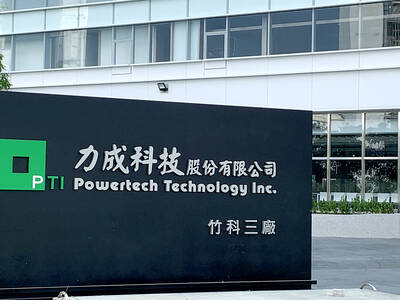The government’s business monitoring system flashed the 10th straight “blue” signal last month, reflecting a continued weakness in the nation’s economy without signs of a recovery, the National Development Council said yesterday.
The council’s Taiwan Business Indicators stood at 15, shedding one point from February, dragged by slacker imports of machinery and electric equipment, the monthly report said.
“Almost all barometers showed negative movements, although the pace of decline did not widen,” council Director Wu Ming-huei (吳明蕙) told reporters.
A “blue” light indicates economic weakness, while “green” suggests stable conditions and a “red” light signifies overheating.
Chance of a signal change is slim before the second half of the year as the current quarter is a slow season for technology product sales, Wu said.
Disappointing earnings results and guidance from Apple Inc raised doubts about expectations of recovery in the third quarter when the technology giant is due to launch new-generation smartphones.
Demand for high-end handsets appears to have saturated, spelling alarm for Taiwanese companies in their supply chain, analysts said.
The reading on money supply is the only constituent index that gained value last month, the council said.
A consensus is building that the economy domestically and globally might fare equally soft this year compared with last year, Wu said, adding that research institutes have revised down GDP forecasts for Taiwan and globally.
The Directorate-General of Budget, Accounting and Statistics is tomorrow to unveil the preliminary GDP reading for the January-to-March period.
On a positive note, the leading economic index series, which foretell the economic scenes one to six months earlier, stayed unchanged at 98.11, due to increased business confidence, semiconductor shipments and higher stock prices, the report said.
The concurrent index series, which mirror the present economic state, shed 0.62 percent to 97.19, in line with poor exports, power usage, retail and wholesale figures, the report said.
Against that backdrop, the consumer confidence index waned further to 80.37 this month, down 0.97 points from last month, according to a survey released by National Central University yesterday.
The gauge on stock investment reported the biggest decline of 2.2 points to 68.4, the report said, as uncertainty heightens ahead of possible policy changes by central banks in Japan and the US.
Daily stock turnover shrank below NT$70 billion (US$2.16 billion) this week as investors ponder their next moves.
Buying interest for durable goods dropped 1.15 points to 90.2, while household income outlook softened 0.95 points to 78.95, the survey said.
Values higher than 100 indicate optimism and scores below the threshold signify a lack of confidence.
The sub-index on the economic outlook dipped 0.5 points to 73.15, indicating a further loss of confidence in the economy, the survey said after polling 2,428 adults by telephone between Tuesday and Thursday last week.

RUN IT BACK: A succesful first project working with hyperscalers to design chips encouraged MediaTek to start a second project, aiming to hit stride in 2028 MediaTek Inc (聯發科), the world’s biggest smartphone chip supplier, yesterday said it is engaging a second hyperscaler to help design artificial intelligence (AI) accelerators used in data centers following a similar project expected to generate revenue streams soon. The first AI accelerator project is to bring in US$1 billion revenue next year and several billion US dollars more in 2027, MediaTek chief executive officer Rick Tsai (蔡力行) told a virtual investor conference yesterday. The second AI accelerator project is expected to contribute to revenue beginning in 2028, Tsai said. MediaTek yesterday raised its revenue forecast for the global AI accelerator used

Taiwan Semiconductor Manufacturing Co (TSMC, 台積電) has secured three construction permits for its plan to build a state-of-the-art A14 wafer fab in Taichung, and is likely to start construction soon, the Central Taiwan Science Park Bureau said yesterday. Speaking with CNA, Wang Chun-chieh (王俊傑), deputy director general of the science park bureau, said the world’s largest contract chipmaker has received three construction permits — one to build a fab to roll out sophisticated chips, another to build a central utility plant to provide water and electricity for the facility and the other to build three office buildings. With the three permits, TSMC

The DBS Foundation yesterday announced the launch of two flagship programs, “Silver Motion” and “Happier Caregiver, Healthier Seniors,” in partnership with CCILU Ltd, Hondao Senior Citizens’ Welfare Foundation and the Garden of Hope Foundation to help Taiwan face the challenges of a rapidly aging population. The foundation said it would invest S$4.91 million (US$3.8 million) over three years to foster inclusion and resilience in an aging society. “Aging may bring challenges, but it also brings opportunities. With many Asian markets rapidly becoming super-aged, the DBS Foundation is working with a regional ecosystem of like-minded partners across the private, public and people sectors

BREAKTHROUGH TECH: Powertech expects its fan-out PLP system to become mainstream, saying it can offer three-times greater production throughput Chip packaging service provider Powertech Technology Inc (力成科技) plans to more than double its capital expenditures next year to more than NT$40 billion (US$1.31 billion) as demand for its new panel-level packaging (PLP) technology, primarily used in chips for artificial intelligence (AI) applications, has greatly exceeded what it can supply. A significant portion of the budget, about US$1 billion, would be earmarked for fan-out PLP technology, Powertech told investors yesterday. Its heavy investment in fan-out PLP technology over the past 10 years is expected to bear fruit in 2027 after the technology enters volume production, it said, adding that the tech would